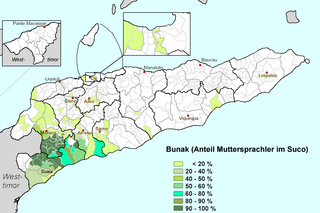Related Research Articles
Kobon is a language of Papua New Guinea. It has somewhere around 90–120 verbs.

Palula and also known as Ashreti (Aćharêtâʹ) or Dangarikwar, is an Indo-Aryan language spoken by approximately 10,000 people in the valleys of Ashret and Biori, as well as in the village of Puri in the Shishi valley and at least by a portion of the population in the village Kalkatak, in the Chitral District of Khyber Pakhtunkhwa province of Pakistan.
Kuman is a language of Chimbu Province, Papua New Guinea. In 1994, it was estimated that 80,000 people spoke Kuman, 10,000 of them monolinguals; in the 2000 census, 115,000 were reported, with few monolinguals. Ethnologue also reported 70,000 second language speakers in 2021.
The Yalë language, also known as Yadë, Nagatman, or Nagatiman, is spoken in northwestern Papua New Guinea. It may be related to the Kwomtari languages, but Palmer (2018) classifies it as a language isolate.

The Bunak language is the language of the Bunak people of the mountainous region of central Timor, split between the political boundary between West Timor, Indonesia, particularly in Lamaknen District and East Timor. It is one of the few on Timor which is not an Austronesian language, but rather a Papuan language of the Timor–Alor–Pantar language family. The language is surrounded by Malayo-Polynesian languages, like Uab Meto and Tetum.
Adzera is an Austronesian language spoken by about 30,000 people in Morobe Province, Papua New Guinea.

Kedah Malay or Kedahan or as it is known in Thailand, Syburi Malay is a Malayic language mainly spoken in the northwestern Malaysian states of Perlis, Kedah, Penang, and northern Perak and in the southern Thai provinces of Trang and Satun. The usage of Kedah Malay was historically prevalent in southwestern Thailand before being superseded by the Thai language. Enclaves of Kedah Malay can be found in Kawthaung District in Myanmar; Ranong and Krabi in upper southern Thailand; Jaring Halus, Langkat and Aceh in Sumatra, Indonesia and up north in Bangkok, central Thailand, where most of the Kedah Malay speakers are descendants of historical settlers from Kedah.
The Yareban or Musa River languages are a small family of Trans–New Guinea languages spoken near the Musa River in the "Bird's Tail" of New Guinea. They are classified within the Southeast Papuan branch of Trans–New Guinea.
Mpur is a language isolate spoken in and around Mpur and Amberbaken Districts in Tambrauw Regency of the Bird's Head Peninsula, New Guinea. It is not closely related to any other language, and though Ross (2005) tentatively assigned it to the West Papuan languages, based on similarities in pronouns, Palmer (2018), Ethnologue, and Glottolog list it as a language isolate.
Boiken is one of the more populous of the Ndu languages of Sepik River region of northern Papua New Guinea. It is spoken around Boiken Creek in Yangoru-Saussia District, East Sepik Province and adjacent islands off the north coast of northern Papua New Guinea.
Ese is a language of Oro Province, Papua New Guinea. Although it is also known as Managalasi, which the Summer Institute of Linguistics regards as pejorative possibly because it is a corruption of Hiri Motu phrase meaning the equivalent of "know nothings", the term "Upper Managalasi" indicates Ömie, another member of Baraic languages. Dialects are Muaturaina, Chimona, Dea, Akabafa, Nami, Mesari, Averi, Afore, Minjori, Oko, Wakue, Numba, Jimuni, Karira. Perhaps 40% of speakers are monolingual.
Yagwoia (Yeghuye), or Kokwaiyakwa, is an Angan language of Papua New Guinea. Dialects are named after the five ethnicities, Iwalaqamalje, Hiqwaye, Hiqwase, Gwase, Heqwangilye.
Fore or ForéFOR-ay is a Kainantu-Goroka language spoken in the Goroka District of Eastern Highlands Province, Papua New Guinea.
Burum is a Papuan language spoken in Morobe Province, Papua New Guinea. Its closest related language is Borong.
Orokaiva is a Papuan language spoken in the "tail" of Papua New Guinea.
Binandere is a Papuan language spoken in the "tail" of Papua New Guinea.
Aion a.k.a. Ambakich is a Keram language of Papua New Guinea. It is only spoken by adults; children grow up speaking Tok Pisin.
Tungag, or Lavongai, is an Austronesian language of New Ireland Province, Papua New Guinea, localized New Hanover, the native name of which is Lavongai.
Mengen and Poeng are rather divergent dialects of an Austronesian language of New Britain in Papua New Guinea.
Iduna is an Austronesian language spoken on Goodenough Island of Milne Bay Province of Papua New Guinea.
References
- ↑ Yareba at Ethnologue (25th ed., 2022)

- 1 2 3 4 5 Weimer, Harry; Weimer, Natalia (1972). "Yareba phonemes". Te Reo. 15: 52–57.
- ↑ Pawley, Andrew; Hammarström, Harald (2018). "The Trans New Guinea family". In Palmer, Bill (ed.). The Languages and Linguistics of the New Guinea Area: A Comprehensive Guide. The World of Linguistics. Vol. 4. Berlin: De Gruyter Mouton. pp. 21–196. hdl: 20.500.12657/23719 . ISBN 978-3-11-028642-7.